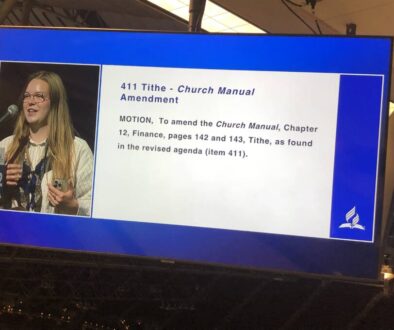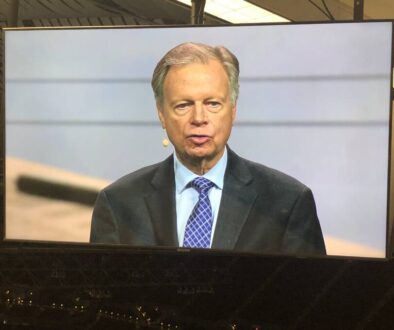Annual Meeting of the Adventist Church in North America Begins
by Atoday News Team
Some of the people arriving for the annual business session of the Seventh-day Adventist Church in North America had some days earlier been in the General Conference (GC) Annual Council. Several observed the contrast was subtle, but clear. At least one item on the agenda may widen the differences considerably.
Officially it is called the Year-end Meeting of the North American Division (NAD) Committee. Each of the 13 ‘divisions’ or regional sections of the GC have one during the time between the Annual Council and the end of the calendar year. Long-established policies dictate that major changes in denominational programs, finances and policies can only be made at this yearly meeting.
The divisions of the GC are described in the denomination’s constitution and bylaws as simply a part of the GC itself. And they are given the full authority of the GC within their territory. This inevitably creates conflicts, especially with the emergence of a division in North America which did not really exist until 1985. It is also true that as the denomination becomes larger, it is no longer possible for a handful of men at world headquarters to manage everything at the level of detail they did only a generation ago. Consequently the delegation of operational space to the divisions has become more and more important as well as frustrating to some who work at world headquarters.
The NAD Committee is different from most of the other division committees in that about half of its members are pastors, teachers and lay leaders. All 58 of the conference presidents are members, as well as all the union conference officers (about 30 individuals), the presidents of the 14 Adventist colleges and universities, the nine union conference education directors, all of the NAD officers and department heads, as well as leaders from several key organizations in health care and other areas. It is a large group with 200 to 300 members participating in each yearly meeting. Most division committees are less than a third this size and have very few pastors and lay leaders in attendance.
Pastor Dan Jackson is the new president of the Adventist Church in North America. He was elected a little over a year ago and this is really the first annual meeting where he has had time to reflect, plan and prepare. Last year the meeting came soon after the GC Session where he was unexpectedly asked to assume leadership and the agenda was focused on the selection of the NAD staff for the next five years.
His report to this year’s meeting started with a one-word theme, “Collaboration.” It was an expression of his exceptionally collegial style. He quoted Ellen White, “those who are called to responsible positions…permit ourselves to feel altogether too much care…We need to trust [Jesus] and go forward.” (Seventh-day Adventist Bible Commentary, Volume 7-A, page 1161) One of the forward steps introduce in the first day of the meeting is a new mission statement specifically for the NAD.
The new statement: “The mission of the North American Division is to reach our territory and the world with the distinctive, Christ-centered Seventh-day Adventist message of hope and wholeness.” As organizational experts generally agree, it is more succinct than the GC mission statement: “The mission of the Seventh-day Adventist Church is to make disciples of all people, communicating the everlasting gospel in the context of the three angels’ messages of Revelation 14:6-12, leading them to accept Jesus as personal Savior and unite with His remnant Church, discipling them to serve Him as Lord, and preparing them for His soon return.”
Pastor Jackson told the committee that in the last year he has spent time on the strategic planning process which would be a key part of the agenda at this meeting, participated in the development of a strategy for the denomination’s media ministries, overseen the reorganization of the Ministerial Department, played a key role in nine union conference constituency meetings and preached a public evangelism campaign in Houston, Texas, one of the ten largest cities in North America.
He also listed a number of challenges facing the Church: “Recognition of the great need…to intensify our outreach” and especially the involvement of Church members in evangelism, church planting and community service. “More involvement for our young people.” Major hurdles for the future of Adventist schools. The financial problems of a denomination in the midst of the Great Recession. More effective use of media, especially the new social media on the Internet.
Research has shown that church outreach activities have largely declined over the last decade both in the amount of activity, the number of members volunteering time and the measurable outcomes. Public awareness of the Adventist Church is also declining and knowledge of precisely what the denomination is all about has never been widespread in the U.S. and Canada.
Some items on the agenda will be quickly voted without much discussion. The committee members have a large binder to work through and if they give detailed debate to every item they will be here until Christmas. It has already been voted to accept the request of the GC to move Guam and Micronesia into the NAD territory. These are mission fields that were long part of the Far Eastern Division, but also happen to be U.S. territories so they have more in common with the NAD. It is a historic addition to a region that has long included the U.S., Canada, Bermuda, two small French islands off eastern Canada and a few largely uninhabited islands near Hawaii.
Two agenda items may spark considerable debate and even conflict beyond this meeting. One has to do with a new policy for ‘local hires.’ This terminology refers to personnel hired with local church or school funds which have long existed in what the denomination’s attorneys have determined was legal limbo. It has long been common for churches of all denominations in America to hire part-time works on a ‘stipend’ basis. For example, most Baptist churches hire a youth pastor for considerably less than what could be considered a full-time salary. This person has another job or may be enrolled in college and is happy to spend as much time as he can working with the teens in the church for perhaps $400 a month.
The denomination’s legal office has recommended this kind of employee in the Adventist Church conform to the legal requirements which were written in the 1940s for union labor working in auto plants and coal mines. That is they must turn in time cards and be paid minimum wage. Their employment must be handled by the conference treasurer’s office even if he turns around and invoices the local church for the cost of the employee. This creates a lot of paperwork for conference treasurers and may prove to be entirely impractical. Most churches ignore these requirements and there are no visible cases of their being challenged, but most denominations do not have the centralized structure of the Adventist Church which might make it a more inviting target for some aggressive Federal attorney. After all, local Adventist churches are not incorporated like most Baptist congregations, and legally exist only as activities of the conference.
In the past year a number of conferences have gone through major changes to make way for this new policy. It remains to be seen how many of them may come back to this meeting with negative experiences and challenge its further implementation.
A more visible potential conflict has to do with NAD Working Policy E-60. This policy has long stated that conference presidents must be ordained ministers. Last year the NAD Committee voted to amend that, making Commissioned Ministers also potentially eligible to hold that office. What is the difference? In a word, gender.
When the GC Session in 1990 refused to move ahead with the ordination of women serving as pastors in the Adventist Church and in 1995 denied the request of the NAD for divisions to be allowed to make their own decisions on the topic, the NAD Committee created a new credential, that of a Commissioned Minister. It provides something of a parallel track for women in ministry and it is despised by some who favor ordaining women, as well as damned by some who are against it.
Over the last decade many conferences have begun to issue a single credential for an “Ordained/Commissioned Minister” and many policy documents have been amended to include this conjoint language. A year ago the NAD Committee inserted it into NAD Working Policy E-60, theoretically opening the door for a woman who is a Commissioned Minister to be elected a conference president.
This created an irregularity in the eyes of some GC officers since the GC Working Policy did not have a similar provision. At the recent Annual Council the NAD and the Trans-European Division (TED) requested that a variance be voted to care for this difference. GC President Ted N. C. Wilson spoke against the request and the delegates voted not to grant it.
Will the NAD Committee go along with this decision? There are several possible outcomes. The NAD Committee might rescind its vote from last year and return to the old language in E-60. Or, it might not rescind its vote and simply wait to see what happens. Frankly, it is unlikely the GC officers will take any action until a woman Commissioned Minister is actually elected a conference president. There are other possibilities that might involve different revisions of the policy language or the appointment of a committee to meet with the GC officers and seek to work out some more acceptable arrangement.
A number of the men currently serving as conference and union presidents in the NAD believe that the refusal to ordain women in ministry and the policy against women serving as conference presidents are simply unbiblical and unjust. They profoundly disagree with the views expressed by the GC president. They do not think that if Europe and North America were allowed to ordain women pastors or elect women to the role of conference president that it would cause significant disunity in the world church. This may be a moment for them to make a statement of their own.
The deeper damage to the Adventist movement is among the members and potential members under 45 years of age. In North America research has shown that about half the young people growing up in Adventist homes leave the church when they become adults. Among the second generation in immigrant churches it is an ever higher percentage. Denominational leaders in Europe, Australia and New Zealand say the same thing is happening there.
It is widely believed that the denomination’s insistence on maintaining discrimination against women on this point is at least partly to blame for the loss of young adults. With the stakes as high as this, if there is no debate on this item it will come as a surprise to most observers.



